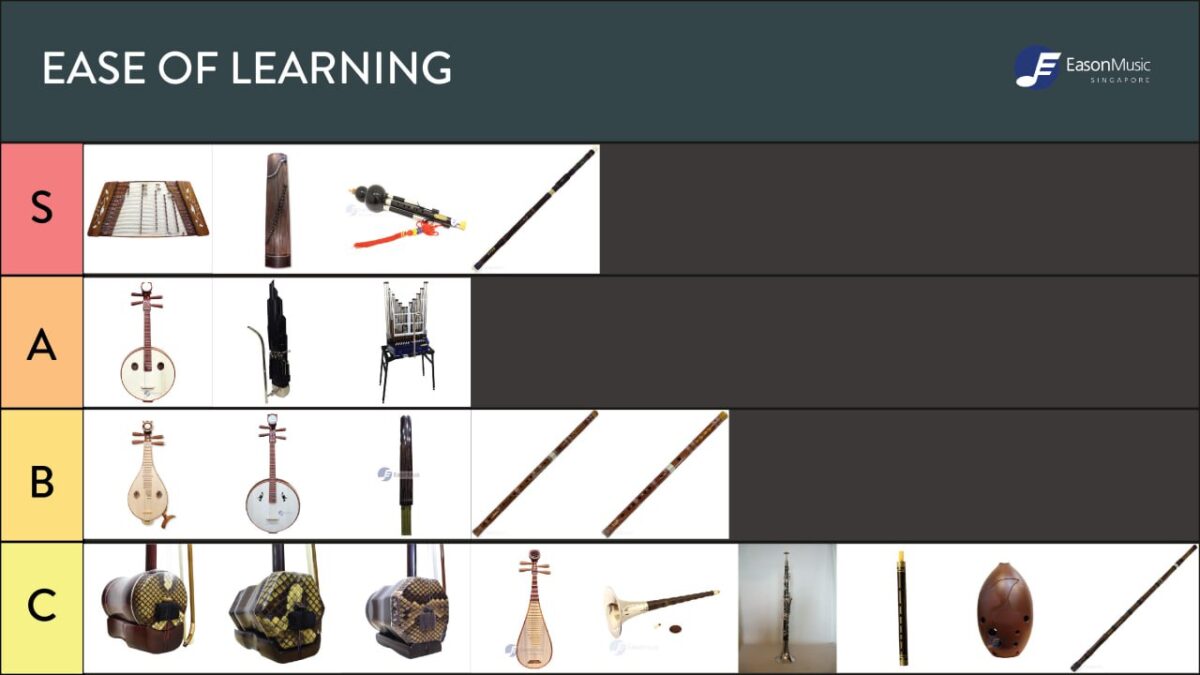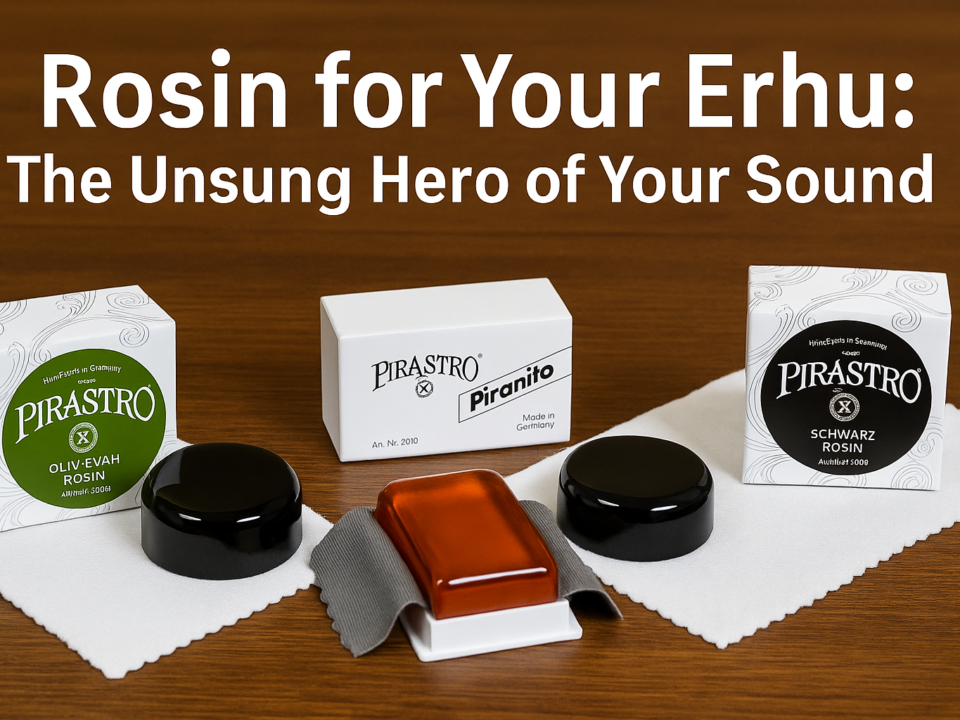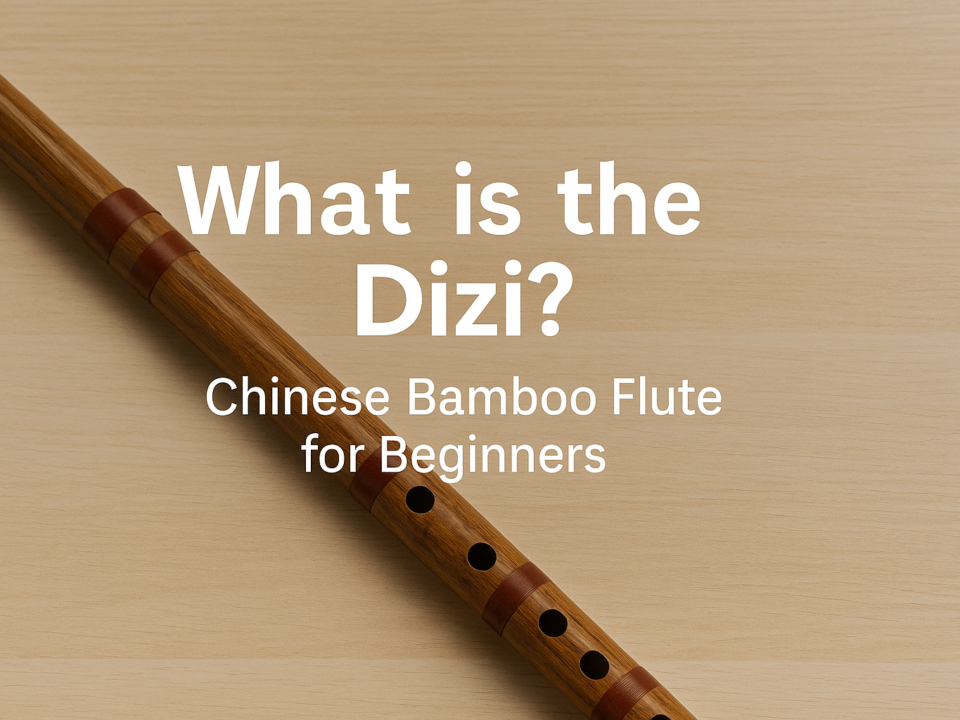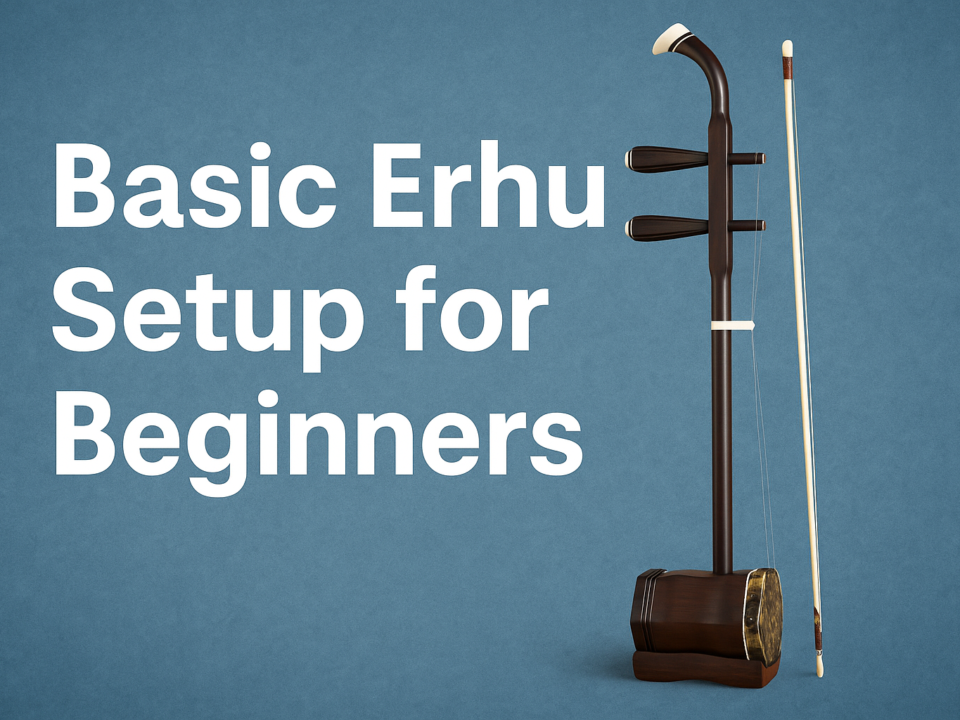
Eason Music School’s First Annual Recital!
February 7, 2024
Demystifying Direct School Admission (DSA): Insights from a Musician’s Perspective
June 27, 2024Have you ever wanted to learn a Chinese instrument, but just don’t know what to start with? With the variety of instruments within the Chinese orchestra, you’re simply spoilt for choice and it can be difficult to choose. But fret not – recently on the Eason Music “Coffee Chat” podcast, Anson and Sung Wah ranked each of the instruments from the Plucked, Winds and Bowed Strings sections to create the FIRST-EVER Chinese orchestra instrument tierlist! So, if you want to know more about picking an instrument for yourself or your child, or even if you’re an experienced musician looking for an interesting take on CO instruments, read on to find out how they did it!
Instruments were ranked into 4 tiers (S, A, B, C, from high to low) based on four main categories:
-
Ease of learning: how easy or complicated is it to pick up each instrument as a beginner?
-
Versatility: how well does this instrument play for both solo and accompaniment? (Think: for Western instruments, piano is a great choice for both solo and accompaniment parts, but instruments like flute and trumpet aren’t commonly used for accompaniment)
-
Ease of listening: would you be able to listen to this instrument play for a long time?
-
Maintenance: how easy would it be to keep the instrument in a quality playable state?
For a quick summary of what we've got to say, take a look at the charts below!
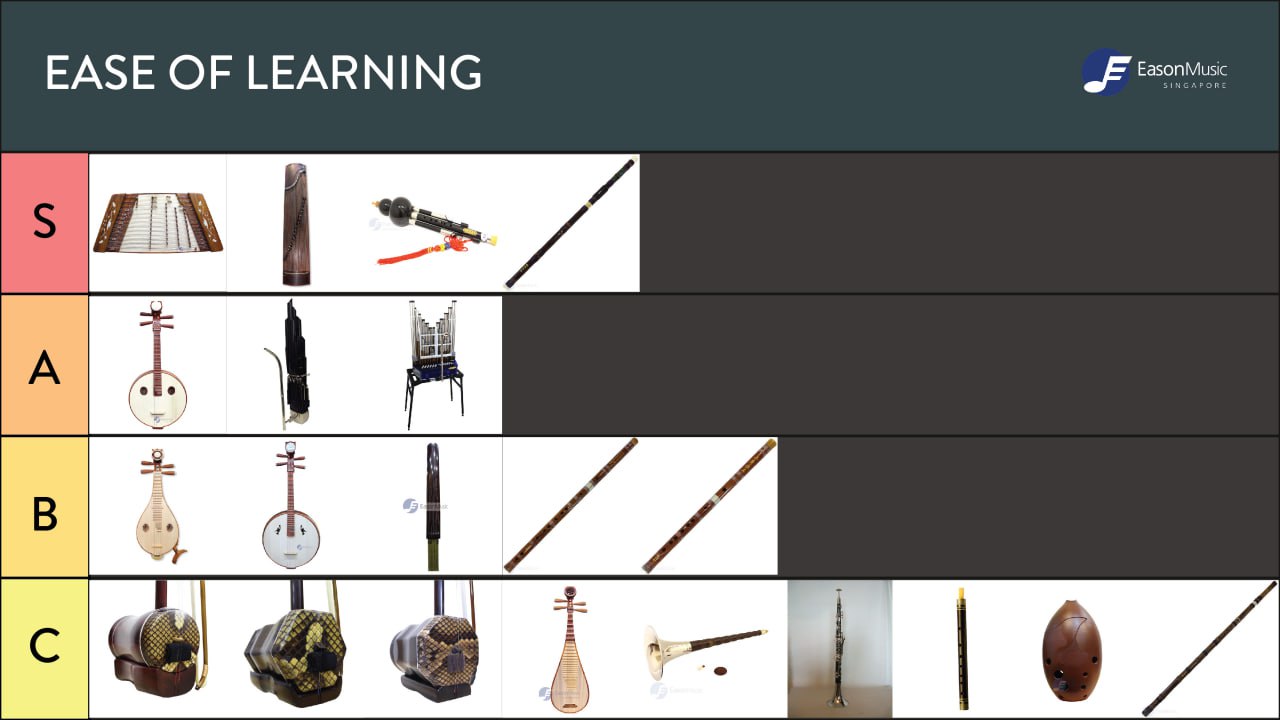
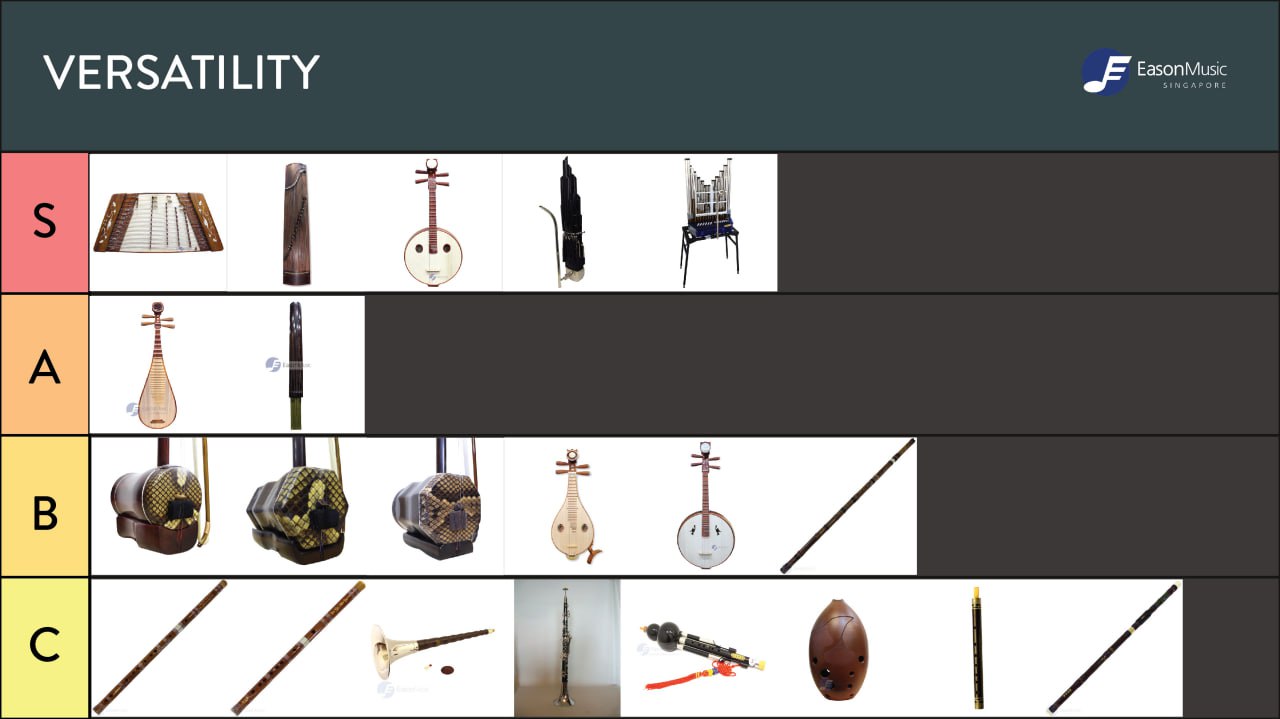
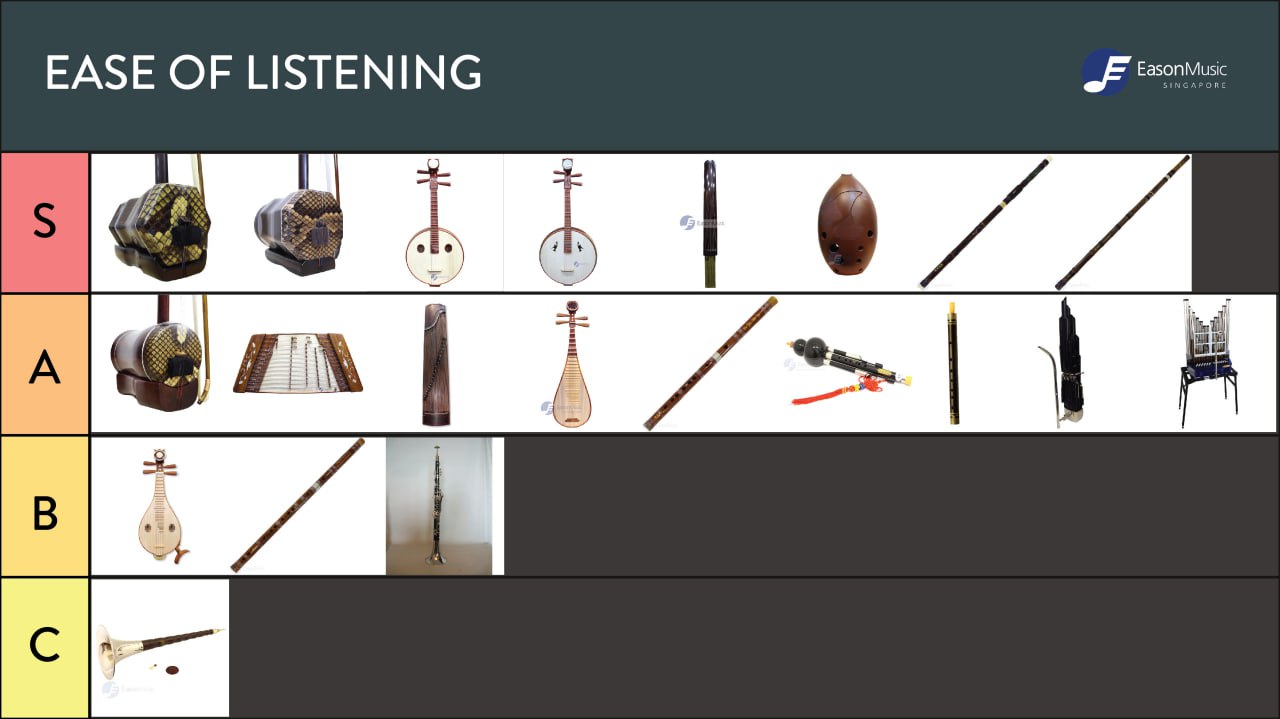
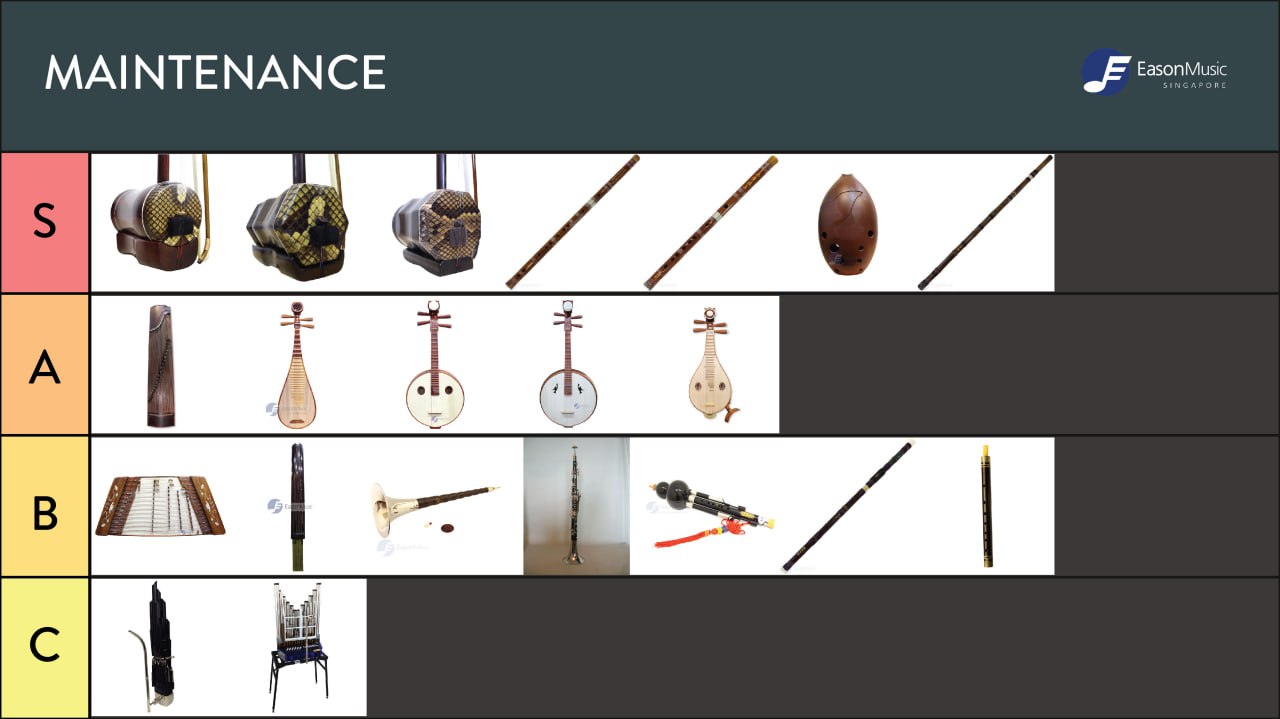
Now that the tiers and criteria have been sorted out, let’s get into the rankings by sections below:
Huqin/Bowed Strings (Erhu, Gaohu, Zhonghu)
1. Ease of learning: C
- Huqin instruments are not fretted, so intonation may be a bit of a challenge! Players have to watch out for their bowing as well. Huqin players should also start off with Erhu before venturing into Zhonghu or Gaohu.
2. Versatility: B
- The huqin instruments are great for accompaniment in an orchestral setting, but individually don’t do that well! They are great choices for solo instruments, especially erhu and gaohu.
3. Ease of listening: S (erhu, zhonghu), A (gaohu)
-
The erhu and zhonghu have a moderate, pleasant range. The gaohu is tuned higher than the erhu, so the high pitch may get a little more difficult to listen to over longer periods of time.
4. Maintenance: S
- All huqin instruments are great to maintain! There’s only 2 strings to change, and the bow only needs to be replaced after quite some time. Just maintaining the snakeskin with some extra-virgin olive oil if it’s getting dry will do.
Tanbo/Plucked Strings (Yangqin, Liuqin, Pipa, Zhongruan, Daruan, Guzheng, Guqin)
1. Ease of learning: S (Yangqin, Guzheng), A (Zhongruan), B (Liuqin, Daruan, Guqin), C (Pipa)
-
-
Yangqin and Guzheng are great to learn, with the Yangqin only using 2 sticks (Qin Zhu), and the Guzheng is already tuned to a pentatonic scale. Instruments in the A and B tier are moderate in terms of technique, with fretting chords and plucking technique using a plectrum (watch out for the Daruan as the size and toughness of the strings may make things a little more difficult!). Playing the Guqin may be more difficult to adapt to at the start. The Pipa would be the most difficult instrument to learn, with each finger on the right hand needed to pluck the strings.
-
2. Versatility: S (Yangqin, Guzheng, Zhongruan), A (Pipa, Guqin), B (Liuqin, Daruan)
-
-
Yangqin, Guzheng and Zhongruan are versatile enough to take on the role of both soloist and accompanist, with their ability to play both chords and soloistic passages. The Pipa and Guqin have very distinct and unique sounds, which may stand out a little if used as accompaniment. Daruan is less commonly used as a solo instrument, while the striking, high-pitched tones of the Liuqin make it difficult to use as an accompaniment instrument.
-
3. Ease of listening: S (Zhongruan, Daruan, Guqin), A (Yangqin, Guzheng, Pipa), B (Liuqin)
-
-
The range of the Zhongruan, Daruan and Guqin are comfortable to listen to for longer periods of time. Using a plectrum on the strings also makes the sound less striking, as compared to instruments like the Yangqin, Guzheng and Pipa which are hit or plucked directly with the fingernails. The Liuqin’s resonant, clear and high-pitched tones make it an impressive choice for soloistic playing, but may get a little uncomfortable to listen to after a while.
-
4. Maintenance: A (Guzheng, Pipa, Zhongruan, Daruan, Liuqin), B (Yangqin, Guqin)
-
-
Changing the strings of the Guzheng is fairly easy, despite the number of strings that the instrument has. Pipa, Zhongruan, Daruan and Liuqin each have only 4 strings to change, making it a breeze to maintain this instrument. The only downside would be issues that may arise with fretted instruments, like buzzing sounds or splitting/dropped frets etc. The Yangqin has many strings (144!) that rust easily and need to be polished fairly regularly, while changing the strings of the Guqin may require more specialized skills or professional help.
-
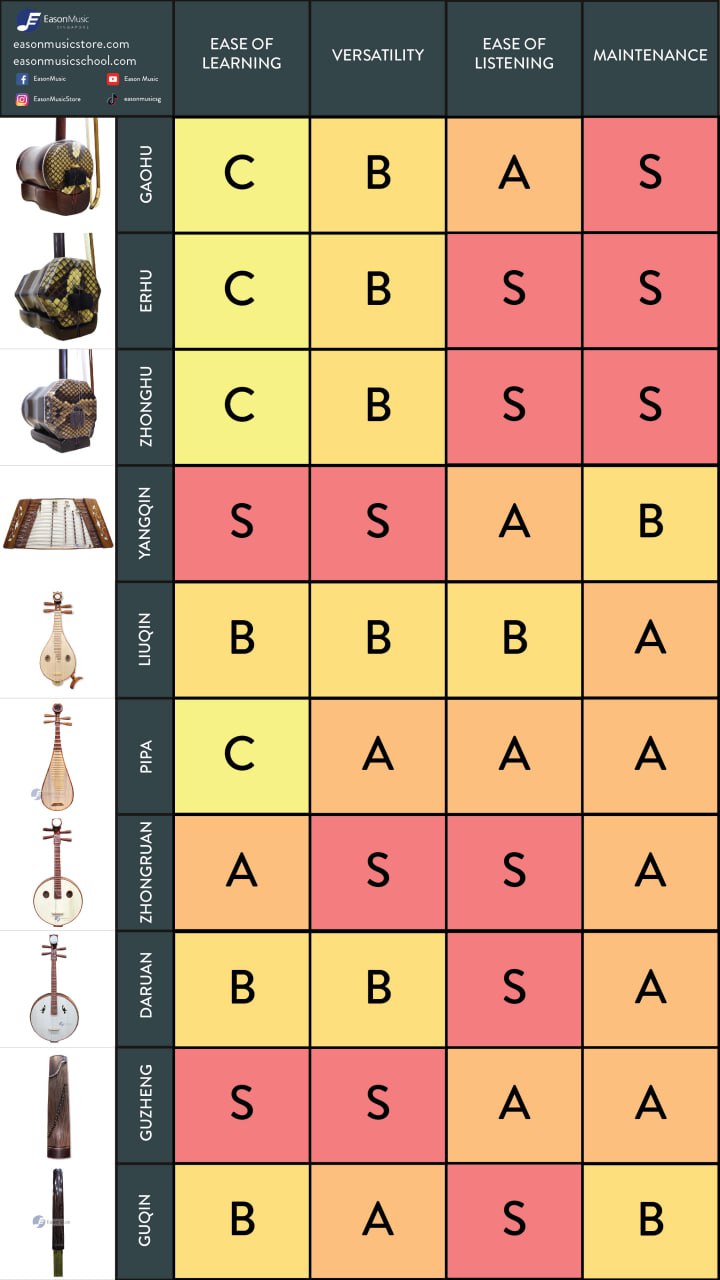
Guanyue/Winds (Bangdi, Qudi, Gaoyin Suona (Gaosuo), Zhongyin Suona (Zhongsuo), Guanzi, Gaoyin Sheng (GYS), Zhongyin Sheng (ZYS), Hulusi, Bawu, Xun, Xiao)
1. Ease of learning: S (Hulusi, Bawu), A (ZYS), B (Bangdi, Qudi, GYS), C (Gaosuo, Zhongsuo, Guanzi, Xun, Xiao)
-
The Hulusi and Bawu are fairly straightforward to learn. The ZYS is manageable as well, with the keys arranged in a keyboard fashion. Instruments in the B and C range are a lot more challenging to perfect as embouchure, fingering and breath control all affect pitch and intonation.
2. Versatility: S (GYS, ZYS), B (Xiao), C (Bangdi, Qudi, Gaosuo, Zhongsuo, Hulusi, Xun, Guanzi, Bawu, Hulusi)
-
GYS and ZYS are great at playing both melody and accompaniment. The shengs are the only wind instruments that can efficiently play and sustain chords, making them a popular choice for solo and accompaniment alike. Though the sound of the Xiao is quite mellow, it is not often used as an accompaniment instrument as it is rare within the orchestra and has a unique tone color. The remaining wind instruments are rarely used as accompaniment instruments due to their clear, piercing sound and volume, and their unique capabilities as an instrument.
3. Ease of listening: S (Xun, Bawu), A (Qudi, Guanzi, Hulusi, GYS, ZYS), B (Bangdi, Zhongsuo), C (Gaosuo)
-
The Xun and Bawu are mellow-sounding, and are good mid-ranged instruments to comfortably listen to. Instruments in the A tier are still within a comfortable range to listen to, though the sound quality of these instruments may be a little more sharp (for example, think of the Guanzi, which sounds like a clarinet but grainier). The pitch of the Bangdi can get a little high, and the Zhongsuo can be a little loud. The Gaosuo is arguably the most infamous for its high pitch, piercing sounds and volume.
4. Maintenance: S (Bangdi, Qudi, Xun, Xiao), B (Gaosuo, Zhongsuo, Hulusi, Bawu, Guan), C (GYS, ZYS)
-
The Dizis, Xun and Xiao are a breeze to maintain. Just a quick wipe down with a microfiber cloth or some mild disinfectant will do (do not stick anything into the Dizis or the Xiao!). The B tier instruments are reed instruments, which depend a lot on the maintenance of the reed. The reeds need to be sanded and “fixed” before using, and the instrument cannot be played properly if the reed has split. GYS and ZYS are costly to maintain as professional skills are required to keep the instrument in good playable condition, and a complete overhaul is needed about once a year.
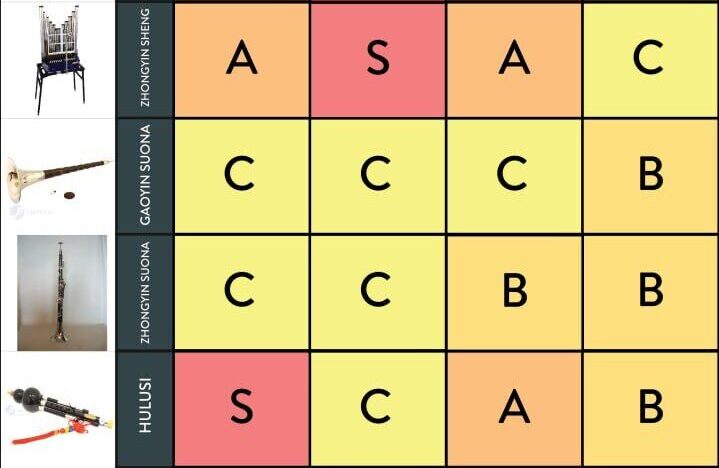
With that, we’ve reached the end of our tierlist! We hope you’ve found what Anson and Sung Wah had to share informative and useful. To check out more of what they had to say about the instruments, check out the Coffee Chat podcast on Apple Music and Spotify. If you’d like to find out more about any of the instruments listed, or to kickstart your learning journey with us, don’t hesitate to drop us a text or email. Happy listening!

